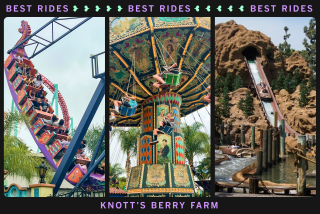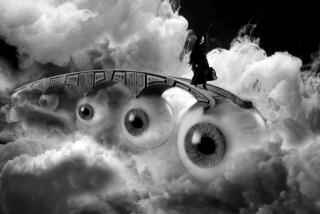Scenic Art Sets Stage for a Family Business : Props: Frank Pera paints backdrops for sale or to rent to movie or TV companies, photographers or party designers.
- Share via
On a recent morning, Frank Pera jaunted on a beach of fine sand, past tall palms swaying in the tropical breeze, almost getting his feet wet in the aqua blue Caribbean waves. But that cruise liner in the background wasn’t moving and Pera’s feet were firmly planted on the cement floor of his Sun Valley studio directly in front of a scenic background.
The art is a relatively portable, 8-foot-high and 15-foot-wide exotic paradise that Pera, 47, a scenic artist and owner of Continental Scenery, painted on wood for an island show by the Princess Cruises company.
This $2,500 piece is almost ready to be shipped to a Caribbean island where it will be propped up on a bandstand to entertain passengers. Next, Pera might have to paint the Mojave desert or Moscow’s Red Square.
He’s done it before. A change of decor is something Pera gets all the time. He’s been creating backdrops for 25 years, first working for movie and television studios, then 10 years ago he started his own firm. Now, his four-person business produces backdrops and props for rent or for sale to movie, television and theater production companies, as well as to photographers and party designers.
Continental Scenery is one of half a dozen scenic shops in Southern California. In a business where word-of-mouth and reputation have a life of their own, Pera has his share of tony customers, including Paramount, Universal, Disney and the television networks. Old film studios also have a big inventory of backdrops, even “decades worth of them. But they’re rolled up in some warehouse and it would take 10 days to locate the one they need,” Pera said. “They can get one from me that same day.”
His company has grown steadily from $150,000 in sales in 1983 to $500,000 in 1992, when Pera sold about 30 backdrops and made more than 350 rental agreements at rates varying from $180 to $1,150 per week.
Pera’s inventory includes the 50-foot-wide nighttime lake scene he created in four days for Disney’s 1991 movie “What About Bob?” starring Bill Murray. There was also the recent television commercial showing eggs rolling out of jail cells, put on by the California Egg Commission. The message was that eggs weren’t as guilty of cholesterol as most thought. The long jail row in the background was Pera’s work of illusion, 40 feet worth of perspective.
And last summer when candidate Bill Clinton campaigned in Los Angeles, his tangible Hollywood connections were obvious when he delivered a speech in front of Pera’s 28-by-14-foot backdrop of the Hollywood sign, a $400-a-week rental so popular that Continental Scenery keeps three versions in stock.
Of course, renting from Pera does not insure success. Michael Dukakis stood in front of the same wind-swept rendition of patriotic red stripes, and a lot of good it did him.
While his film industry clients generate the glitzy part of Pera’s work, the bread-and-butter income comes from rental of the 500 backdrops in his inventory, many of them skies or ocean scenes plus Monument Valley in Arizona, a western saloon, an overview of Los Angeles and sunsets.
Rai Calouri, director of operations for passenger programs for Princess Cruises in Century City, has been a Pera customer for two years, purchasing custom scenic art for shows aboard their nine ships. “Frank is a talented artist. His strength is a good theatrical sense. Sometimes it takes a few tries to get the design and look we want, but we’ve learned to work with that.”
“Everybody is budget-conscious these days and renting a drop is a quick inexpensive way to put up a set,” Pera explained. Pera might have the artistic eye for design, but he also seems to have a sharp one for frugal accounting. His competition includes much older and larger backdrop studios, such as J.C. Backings in Los Angeles, or firms with deeper financial support, such as Warner Brothers in Burbank.
Continental Scenery is a small family business. Pera’s wife, Irene, is the secretary. He also employs a driver to deliver and pick up backdrops and a general utility helper, but Pera is the only artist. A year and a half ago, he moved out of his Hollywood office to a cheaper studio in Sun Valley where he saves about $1,500 a month.
Still, winning bids for major custom projects takes some aggressive moves. One compromise Pera likes to reach with prospective clients is to shave one third off the price in exchange for getting the scenery back so he can rent it out again.
In “What About Bob?” the lake scene backdrop cost Disney $5,000 and Pera contends he did barely better than breaking even, but now he has the backdrop to rent out at $750 a week. So money will keep coming in from his initial 96 hours of labor: from building a 50-foot-wide wooden frame, sewing the $100-a-yard cotton canvas onto it, stretching and priming it with background color, sketching the design and filling in textures and details of the sky, the pine trees, the shore and the water.
“I am the only union scenic artist in this shop and sometimes I can’t afford to pay myself union wages,” Pera said. Top union wage is $30 an hour. “If I had to employ a union scenic artist, I just couldn’t make it.”
However, not all sales are break-even situations. Some customers such as Princess Cruises make up a steady 20% of Continental Scenery’s business and help even out the feast-or-famine nature of the film industry. Another reliable 10% of his income is from custom art for parties.
Pera is one of only 250 scenic artists locally who are members of the International Alliance of Theatre and Stage Employees. Continental Scenery remains small, according to Ted Rubin, business representative of Local 816 of the IATSE, but Pera has carved a comfortable niche in the scenic art market. “He is talented, but he doesn’t do enormous pieces, 40 by 200 feet. His shop is not equipped for that,” Rubin said.
Pera’s size was hard enough to reach, though. Rare are the artists who paint well, realistically, and fast enough to meet deadlines. Painting large is another challenge: on a 180-foot-long city skyline, a simple blunder can turn into a 20-foot disgrace.
As far back as he can remember, Pera was emersed in art. Painting posters in primary school and later illustrating his high school newspaper led him to study commercial art in night college classes while working during the day as a technical illustrator drawing Boeing airplane parts for Butler Data Systems. After graduating, he got a job as a graphic artist at McDonnell Douglas in Lomita.
In 1968, a fellow illustrator gave him the idea of painting for the entertainment industry. Pera started with a position as an apprentice scenic artist for CBS. Through the following 14 years, he journeyed from TV to film studios as a full-fledged union scenic artist.
In 1983, he decided there was room for a small company to compete against what he said are the two largest independent scenic art companies, J.C. Backings and Grosh Scenic Backings.
Pera took out an ad for his custom work in the entertainment industry’s Yellow Pages. Orders came in and Pera asked for an advance on payment for each project to get his business afloat.
Even though Pera’s projections for 1993 would have Continental Scenery reach $1 million in revenue, that’s not really what motivates him.
“Michelangelo was a scenic artist. And maybe in the future they’ll be unrolling backdrops that we have done here, saying, ‘Look, this is the work of Frank Pera from Continental Scenery,’ ” Pera said.
Then again, maybe not. But as long as the money keeps rolling in, Pera can take a real sea cruise, instead of just painting one.
More to Read
Sign up for The Wild
We’ll help you find the best places to hike, bike and run, as well as the perfect silent spots for meditation and yoga.
You may occasionally receive promotional content from the Los Angeles Times.






